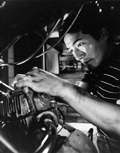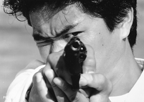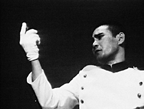Part 5
Caught between Different Worlds / When the 27th Parallel Disappears
From the mid-1960s through the 1970s, Okinawa was on the cusp of a changing era. Japan had freed itself from its post-war situation and secured the relative power granted to members of “The West” in the context of the East-West Cold War, and also was trying to wash itself of the “post-war.” Against this backdrop, everyone was strongly conscious of “Okinawa’s Return,” both socially and politically. Then, in 1972, Okinawa reverted to Japanese sovereignty. From that day on, in contrast to the surging tide of assimilation to mainland Japan, the contradictions that had been obscured by the reversion movement were exposed, sometimes distorted, sometimes creating sharp conflicts. A number of films examined various phases of the changing eras. Perhaps none of them provided the absolutely correct response. Still, artists considered these conditions and produced visual works that expressed a consciousness of the distance from their own positions. At the same time in Okinawa there was the beginning of a struggle to create a new visual style.
| 1 | Accumulated Voices, Entangled Gazes |
 The Gentle Japanese
The Gentle Japanese
(“Yasashii Nipponjin”)- 1971 / B&W / 16mm (orig. 35mm) / 118 min
Director: Higashi Yoichi
Script: Higashi Yoichi, Maeda Katsuhiro
Photography: Ikeda Denichi
Sound: Kubota Yukio
Producer: Takagi Ryutaro
Cast: Kawarasaki Choichiro, Itami Juzo, Midori Mako
Production Company: Higashi Productions
Source: Siglo
The protagonist of The Gentle Japanese is a boy named Shaka—a name with the same pronunciation in Japanese as the Buddha. A survivor of the mass suicides on Tokashiki Island, Kerama Archipelago at the end of the war in Okinawa, he loses his memory of these events and moves to Tokyo. His life is twofold psychological and geographic alienation, and the more uneventfully his life in the metropole proceeds, the more strongly he feels that uneventfulness is not right. In questioning the terms of existence itself, he also asks what it means to be Japanese. Ultimately, this is a question contemporary Japanese have failed to answer, and a theme that is continuously postponed.
| 2 | In the Place of Violence: The Labyrinth of Resistance |
 Okinawa Yakuza War
Okinawa Yakuza War
(“Okinawa yakuza senso”)- 1976 / Color / 35mm / 96 min
Director: Nakajima Sadao
Script: Takada Koji, Konami Fumio
Photography: Akatsuka Shigeru
Editing: Horiike Kozo
Music: Hirose Kenjiro
Art Director: Ikawa Norimichi
Cast: Matsukata Hiroki, Chiba Shinichi, Umemiya Tatsuo, Watase Tsunehiko, Shindo Emi, Narita Mikio
Production Company, Source: Toei
This is an action movie set in 1971, the year before the reversion of Okinawa to Japan. Two plots mingle, one featuring a conflict between local and mainland yakuza gangs, and the other an internal struggle within the Okinawa gang itself. Made with a documentary touch, this film also offers a fascinating glimpse of Japan’s gaze on America formed through the filter of Okinawa. Screenings in Okinawa were prohibited because the images of Okinawa yakuza were felt to hit too close to home, giving this film added interest.
 The Miracle of Joe, the Petrel
The Miracle of Joe, the Petrel
(“Umitsubame Jo no kiseki”)- 1984 / Color / 16mm (orig. 35mm) / 134 min / English subtitled version
Director: Fujita Toshiya
Script: Konami Fumio, Fujita Toshiya, Uchida Eiichi
Based on the novel by: Saki Ryuzo
Photography: Suzuki Tatsuo
Editing: Inoue Osamu
Sound: Beniya Kenichi
Music: Uzaki Ryudo
Art Director: Mochizuki Masateru
Planning: Mifune Shiro
Executive Producer: Okuyama Kazuyoshi
Producer: Nabeshima Hisao
Cast: Tokito Saburo, Fujitani Miwako, Shimizu Kentaro, Satsuki Midori, Harada Yoshio, Mifune Toshiro
Production Companies: Mifune Productions, Shochiku Fuji
Source: The Japan Foundation
By the time this film was made in 1984, over ten years had passed since the upheaval accompanying Okinawa’s reversion to Japan, and the stresses produced by the “mainland takeover” and an overall feeling of running adrift began to surface. This work depicts the youth in the turbulance of the time. The protagonist, Joe, is a yakuza kid with an Okinawan mother and Filipino father, who flees to the Philippines like a petrel when an argument accidentally ends in murder. Joe’s demise makes this film too brutal to be called a youth picture. More than the life of a doomed yakuza, it depicts the dark days of an Okinawa that has lost its sense of place and purpose.
| 3 | The Penetration of the “Yamato Era” and the Construction of “Okinawa” |
 1975 Okinawa Summer
1975 Okinawa Summer
(“1975 Okinawa nu natsu”)- 1975 / B&W / 16mm / 15 min
Director: Tomimoto Minoru
Assistant Directors: Jahana Yuzuru, Yoshida Naoki
Photography: Sasage Hiroshi
Sound: Aihara Masayuki
Source: Tomimoto Minoru
This film captured the summer of 1975, when the International Ocean Exposition was held in Okinawa, themed “The Sea and Its Hopeful Future.” The goal of catalyzing Okinawan economic development was loudly trumpeted, and the whole island was caught up in expo fever. This documentary conveys the irritation felt toward all of the hype. Crowds both welcoming and protesting the Crown Prince’s visit to Okinawa are captured with unsteady camerawork and strained framing, and voices of politicians layered over the images indicate the political significance of the expo.
 When Calling Jahana Noboru
When Calling Jahana Noboru
(“Jahana Noboru o yobu toki”)- 1976 / B&W / 16mm / 30 min
Director, Source: Tomimoto Minoru
Four years after the reversion of Okinawa to Japan, three Okinawan intellectuals recount their views of the folk hero Jahana Noboru. Historian Osato Koei, dramatist Ikemiyagi Shui and philosophy historian Arakawa Akira each draw their own associations from the repertoire of images linked to Jahana Noboru. This striking film will challenge you to rethink how the madness-tinged heroism of Jahana relates to the conceptualization of Okinawa itself.
Yamangunutida (The Gushiken Yoko Story)
 1978 / B&W / 16mm / 35 min
1978 / B&W / 16mm / 35 min
Director: Jahana Yuzuru
Photography: Fukada Hisashi
Sound: Aoki Kiyokado
Cast: Kurashita Yoshikazu, Agarie Kiyonari, Kinjo Miyuki, Tanahara Hirofumi, Tanahara Mika
Source: Jahana Yuzuru
This dramatic work is based on the true story of Gushiken Yoko, the first world-class boxing champion to emerge from Okinawa. The film covers the high school years of Gushiken, telling the story of a youth possessed with a love of boxing in the tumultuous atmosphere of Okinawa during the early 1970s. The film’s title means “the sun of the young mischief-maker” in Yaeyama dialect. This film shows a youth doggedly pursuing his own goals in the exaltation of Okinawan society before reversion to Japan.
The Life of Okinawa Part 1: Indigenous Island Fauna
(“Okinawa retsuden dai ich: Shima gwa”) 1978 / B&W / 16mm / 75 min
1978 / B&W / 16mm / 75 min
Director, Photography: Yoshida Yutaka
Narrator: Matsuda Yusaku
Editing: Takagi Tetsu
Music: Kina Shokichi
Production Company: Teruma Productions
Source: Yoshida Yutaka
This documentary shows people protesting the construction of a Crude Oil Tankage Service facility in Kin Bay on the eastern shore of the Okinawan main island following the reversion of Okinawa to Japan in 1972. Conveys a timeless approach to “resistance” from multiple perspectives, including young men who organize a union, pig farmers who advocate the return of Okinawan native livestock, women who sang ryuka (Ryukyuan poetry) during protests, and the up-and-coming singer, Kina Shokichi.
 Act 1, Scene 1 Okinawa Jinruikan
Act 1, Scene 1 Okinawa Jinruikan
(“Hitomaku Hitoba: Jinruikan”)- 1978 / Color / Video / 25 min
Director: Moriguchi Katsu
Photography: Taguchi Hiroshi
Editing: Aoki Hideaki
Sound: Kawada Yukio
Narrator: Masukata Katsuhiro
Producer: Ujita Hiroshi
Production Company, Source: Nippon Television Network Corporation (NTV)
Broadcast Date: July 30, 1978
This TV documentary intermingles Chinen Seishin’s play Jinruikan with contemporary scenes of Okinawa in 1978. Chinen’s play Jinruikan takes its theme from an incident at the Osaka Industrial Expo in 1903. At an exhibit intended to depict the human race, Ryukyuan people were displayed as “alien races nearby mainland Japan” along with the Ainu from Hokkaido, a mountain tribe in Taiwan, and Koreans. The significance of the era that Okinawa was about to endure became visible through the intersection of three elements: the achievement of Jinruikan as a play, the members of the Sozo Ichiba dramatic troup who perform in it, and Okinawa in 1978.
